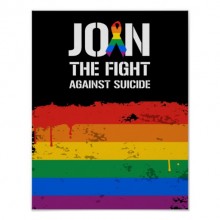Lesbian and bisexual female teens were more than twice as likely as straight male youths to have attempted suicide
Lisa Rapaport | ReutersPhoto: GLAAD

(Reuters Health) – Youth 12 to 14 years old who identify as lesbian, gay, bisexual and transgender (LGBT) are much more likely to die by suicide than their heterosexual peers, a disparity that persists but becomes less pronounced by early adulthood, a U.S. study suggests.
While 24 percent of the suicide deaths in the 12 to 14 age group were among LGBT youth in 2013-2015, this dropped to 8 percent of suicides among young adults 25 to 29 years old, researchers report in the Journal of Adolescent Health.
Higher suicide rates among LGBT youth have been documented before, but the current analysis of suicide deaths over two years among Americans 12 to 29 years old offers fresh insight into what factors are most likely to contribute to these fatalities, said study author Geoffrey Ream of Adelphi University in Garden City, New York.
“We already knew, or at least suspected, that younger people are especially vulnerable to the stress of coming out,” Ream said by email. “This is because they don’t have the psychological resources or personal independence to handle things themselves that they will have when they are older.”
While the study wasn’t designed to prove whether or how the stress of coming out or living as a sexual minority might directly contribute to suicide, the results do show clear differences in how often certain circumstances are associated with these fatalities for young people with different sexual and gender identities.
The researchers looked at national data on 10,311 suicides, limiting their analysis to the 2,209 individuals whose sexual orientation or transgender status was noted in their records. The study team found that most of those who died by suicide, about 73 percent, identified as heterosexual males. About 18 percent of the fatalities were heterosexual females, 2.2 percent were gay males, 2.9 percent were lesbians, 0.8 percent were bisexual males, 0.5 percent were bisexual females, 0.7 percent were transgender males and 0.5 percent were transgender females.
Compared to heterosexual young men, lesbians and bisexual females were more than twice as likely to have prior suicide attempts, and transgender males were almost four times as likely to have such a history.
Bisexual females were most likely to have a history of suicidal thoughts, however, at rates more than six times higher than heterosexual males. Bisexual females were also almost 24 times more likely to have a diagnosed mental illness.
Firearms were used for suicides most often by heterosexual and bisexual males, but used less often by other sexual minorities and rarely by transgender youth.
Family problems most often contributed to suicides among younger people and gay men in the study, while relationship challenges with intimate partners were more often a factor for older people and lesbians.
About one-third of the LGBT youth in the study died while being treated for a mental illness, often while taking psychiatric medications, the study also found.
One limitation of the study is that the vast majority of suicides in the national database used for the study didn’t include any information on sexual orientation, leaving a relatively small sample of deaths for the analysis.
Researchers also could not determine if LGBT youth were more likely to have their sexual identity noted in the law-enforcement and medical examiner records related to their deaths, which could have affected the overall representativeness of the sample.
“Suicide is not caused because of their LGBT identify, but rather by how the world reacts to their identity,” said John Ayers, a researcher at the University of California, San Diego who wasn’t involved in the study.
However, the findings suggest that parents and healthcare providers need to pay close attention to the unique factors that may contribute to suicides among LGBT youth, Ayers said by email.
“We need to be vigilant and ensure that LGBT persons at risk of suicide are getting the support they need,” Ayers said.
SOURCE: bit.ly/2twFw7a Journal of Adolescent Health, online January 30, 2019.